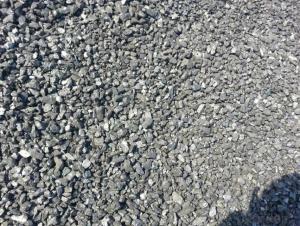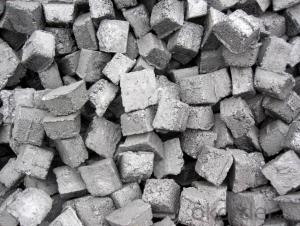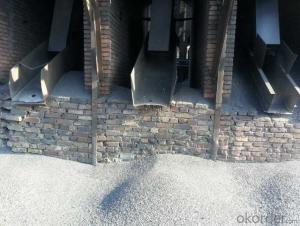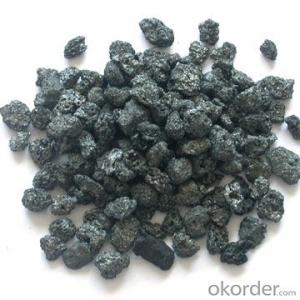Carbon Raiser FC90-95 Calcined Anthracite Coal
- Loading Port:
- Tianjin
- Payment Terms:
- TT OR LC
- Min Order Qty:
- 20 m.t.
- Supply Capability:
- 5000 m.t./month
OKorder Service Pledge
OKorder Financial Service
You Might Also Like
Packaging & Delivery
Carbon Raiser FC90-95 Calcined Anthracite Coal
25kgs/50kgs/1ton per bag or as buyer's request
Specifications
Carbon Raiser FC90-95 Calcined Anthracite Coal
Calcined Anthracite
Fixed carbon: 90%-95%
S: 0.5% max
Size: 0-3. 3-5.3-15 or as request
Carbon Raiser FC90-95 Calcined Anthracite Coal
It used the high quality anthracite as raw materials through high temperature calcined at over 2000 by the DC electric calciner with results in eliminating the moisture and volatile matter from anthracite efficiently, improving the density and the electric conductivity and strengthening the mechanical strength and anti-oxidation. It has good characteristics with low ash, low resistvity, low sulphur, high carbon and high density. It is the best material for high quality carbon products.
Advantage:
Carbon Raiser FC90-95 Calcined Anthracite Coal
1. strong supply capability
2. fast transportation
3. lower and reasonable price for your reference
4.low sulphur, low ash
5.fixed carbon:95% -90%
6..sulphur:lower than 0.3%
General Feature:
Carbon Raiser FC90-95 Calcined Anthracite Coal
| FC | 95 | 94 | 93 | 92 | 90 |
| ASH | 4 | 5 | 6 | 6.5 | 8.5 |
| V.M. | 1 | 1 | 1 | 1.5 | 1.5 |
| S | 0.3 | 0.3 | 0.3 | 0.35 | 0.35 |
| MOISTURE | 0.5 | 0.5 | 0.5 | 0.5 | 0.5 |
Pictures
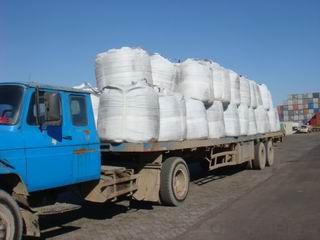
- Q:What are the impacts of carbon emissions on biodiversity?
- Carbon emissions have significant impacts on biodiversity. One of the main consequences is climate change, which is caused by the release of greenhouse gases, including carbon dioxide, into the atmosphere. As the Earth's temperature rises, it disrupts the delicate balance of ecosystems, leading to the loss of biodiversity. One of the major effects of climate change on biodiversity is habitat loss. Many species are adapted to specific environmental conditions, and as these conditions change, their habitats become unsuitable. This can lead to the extinction of species that are unable to adapt or migrate to new areas. Coral reefs, for example, are highly sensitive to temperature changes, and as the ocean becomes warmer due to carbon emissions, many coral species are at risk of bleaching and dying off. Another impact of carbon emissions on biodiversity is the disruption of ecological interactions. Many species rely on specific relationships with other species for survival, such as pollination or predation. Climate change can alter the timing of these interactions, potentially causing mismatches between species. For example, if flowering plants bloom earlier in the year due to warmer temperatures, but their pollinators are not yet active, it can result in reduced pollination and reproductive success. Carbon emissions also contribute to ocean acidification, which is the absorption of carbon dioxide by seawater, leading to a decrease in pH. This acidification affects marine organisms, particularly those with calcium carbonate shells or skeletons, such as corals, mollusks, and some plankton. The increased acidity makes it difficult for these organisms to build and maintain their protective structures, potentially leading to population declines and ecosystem disruptions. Overall, the impacts of carbon emissions on biodiversity are far-reaching and profound. They not only threaten individual species but also disrupt entire ecosystems and their functioning. To mitigate these effects, it is crucial to reduce carbon emissions and transition to cleaner, more sustainable energy sources. Additionally, conserving and restoring habitats, implementing effective conservation strategies, and promoting sustainable land and water management practices can help protect and restore biodiversity in the face of climate change.
- Q:What is carbon black used for?
- Carbon black is a versatile substance that finds applications in various industries. Primarily, it is used as a pigment and reinforcing filler in the production of rubber products, such as tires, hoses, and belts. The addition of carbon black enhances the strength, durability, and resistance to abrasion of rubber materials. Additionally, carbon black is used as a coloring agent in inks, paints, and coatings due to its excellent light-absorbing properties. It provides intense black color and improves the UV resistance of these products. Moreover, carbon black is utilized in the production of plastics, where it acts as a filler to enhance the mechanical properties of plastic components and reduce their cost. In the energy sector, carbon black is employed as a conductive additive in batteries and fuel cells. Its high electrical conductivity enhances the performance of these energy storage devices. Carbon black is also used in the manufacture of electrodes for supercapacitors, where its large surface area enables efficient energy storage. Furthermore, carbon black has applications in the construction industry as a reinforcing agent in concrete and asphalt. It enhances the strength and durability of these materials, making them more resistant to cracking and weathering. In summary, carbon black is widely used in the production of rubber, plastics, inks, paints, coatings, batteries, fuel cells, supercapacitors, and construction materials. Its properties as a pigment, reinforcing filler, coloring agent, and conductive additive make it a valuable material in numerous industrial applications.
- Q:What are the effects of carbon emissions on the stability of peatlands?
- Carbon emissions have significant effects on the stability of peatlands. Increased levels of carbon dioxide in the atmosphere contribute to global warming, which in turn accelerates the decomposition of organic matter in peatlands. This decomposition releases even more carbon dioxide, creating a positive feedback loop that further exacerbates climate change. Additionally, rising temperatures and changing precipitation patterns can lead to the drying out of peatlands, making them more prone to wildfires. These fires release massive amounts of carbon dioxide into the atmosphere, further contributing to climate change. Overall, carbon emissions threaten the stability of peatlands by accelerating their degradation and releasing large amounts of greenhouse gases.
- Q:What kinds of barbecue carbon do you have?
- Common carbon on the market are: flammable carbon, charcoal, carbon three mechanisms. Flammable carbon available in outdoor stores, there are two kinds of square and pie. The surface of flammable carbon has a flammable layer, which is easier to ignite than ordinary charcoal.
- Q:What is the role of carbon in the human body?
- Carbon plays a critical role in the human body as it is the basic building block of organic compounds. It forms the backbone of essential molecules like proteins, carbohydrates, lipids, and nucleic acids, which are vital for various biological processes. Additionally, carbon helps regulate energy metabolism, aids in cellular respiration, and is involved in the synthesis of hormones and neurotransmitters. Overall, carbon is essential for the structure, function, and overall health of the human body.
- Q:What are the consequences of increased carbon emissions on urban areas?
- Urban areas are significantly affected by the increase in carbon emissions, which have notable impacts on various aspects. One of the most significant consequences is the worsening of air pollution. The release of harmful pollutants like nitrogen oxides and particulate matter is contributed by carbon emissions, especially from vehicles and industrial activities. These pollutants can cause respiratory problems, worsen existing health conditions, and increase the risk of lung cancer and cardiovascular diseases among urban residents. Moreover, the increase in carbon emissions leads to the occurrence of urban heat islands. This happens because carbon dioxide and other greenhouse gases trap heat in the atmosphere, resulting in higher temperatures in urban areas. This effect is particularly pronounced due to the abundance of concrete and asphalt surfaces that absorb and radiate heat. Consequently, urban areas experience higher temperatures compared to nearby rural areas, further intensifying the discomfort and health risks associated with heat stress, particularly for vulnerable populations like the elderly and those with limited access to cooling resources. The consequences of increased carbon emissions also extend to the natural environment. Urban green spaces and ecosystems are negatively affected as higher levels of carbon dioxide disrupt plant growth and reduce biodiversity. This exacerbates the loss of natural habitats and the degradation of urban ecosystems, leading to a decline in the provision of ecosystem services such as air purification, temperature regulation, and stormwater management. Additionally, increased carbon emissions have economic implications for urban areas. As carbon emissions rise, the cost of addressing climate change-related challenges like flooding and extreme weather events increases. This puts a strain on the budgets of local governments and may result in higher taxes or reduced funding for other essential services. To tackle these consequences, it is crucial for urban areas to implement strategies that reduce carbon emissions and promote sustainability. This includes investing in public transportation, encouraging the use of renewable energy sources, promoting energy-efficient buildings, and implementing policies to reduce vehicle emissions. By adopting these measures, urban areas can mitigate the negative effects of increased carbon emissions and create healthier, more sustainable environments for their residents.
- Q:How does carbon affect the stability of ecosystems?
- Carbon plays a crucial role in the stability of ecosystems as it is a key component of all living organisms. It affects stability primarily through the carbon cycle, where it is exchanged between the atmosphere, plants, animals, and soil. Carbon dioxide, a greenhouse gas, regulates the Earth's temperature and climate. Excessive carbon emissions from human activities, such as burning fossil fuels, contribute to climate change, which disrupts ecosystems and poses risks to biodiversity, water resources, and food production. Additionally, carbon is essential for photosynthesis, the process by which plants convert CO2 into oxygen and organic compounds, supporting the entire food chain. Hence, its availability and balance are essential for maintaining the stability and functioning of ecosystems.
- Q:How to distinguish carbon rods to identify carbon fishing rods?
- I'm also waiting to learn! It seems all very busy, the masters are not on-line
- Q:What are the impacts of carbon emissions on the stability of mangroves?
- Carbon emissions have detrimental effects on the stability of mangroves, which are crucial coastal ecosystems. The increased levels of carbon dioxide (CO2) in the atmosphere contribute to global warming, leading to rising sea levels and increased frequency and intensity of storms. These changes directly impact the stability of mangroves in several ways. Firstly, rising sea levels caused by global warming can result in increased inundation of mangroves. As the sea level rises, saltwater intrusion occurs more frequently, affecting the delicate balance of saltwater and freshwater in mangrove ecosystems. This can lead to the displacement and decline of mangroves, as they struggle to adapt to the changing conditions. Secondly, the increased frequency and intensity of storms associated with climate change can cause physical damage to mangroves. Mangroves act as a natural barrier, protecting coastlines from storm surges by absorbing wave energy. However, with stronger storms, the resilience of mangroves is tested, and they may be uprooted or destroyed, leaving the coastlines vulnerable to erosion and further damage. Furthermore, carbon emissions are also linked to ocean acidification, which occurs as the excess CO2 in the atmosphere is absorbed by the oceans. Acidic waters can negatively impact the growth and development of mangroves, as they are sensitive to changes in pH levels. This can lead to reduced productivity, stunted growth, and even death of mangroves, further destabilizing these ecosystems. The stability of mangroves is vital for both the environment and human populations. Mangroves provide essential habitat for various species, serving as a nursery for fish and supporting biodiversity. They also act as carbon sinks, sequestering significant amounts of CO2 from the atmosphere. Additionally, mangroves play a crucial role in coastal protection, mitigating the impacts of erosion, storm surges, and flooding. To mitigate the impacts of carbon emissions on the stability of mangroves, it is crucial to reduce greenhouse gas emissions and limit global warming. This can be achieved through the adoption of clean energy sources, conservation efforts, and reforestation initiatives. Protecting and restoring mangrove habitats is equally important, as it helps maintain their stability and resilience to climate change impacts.
- Q:How are carbon fibers used in manufacturing?
- Carbon fibers are used in manufacturing for their exceptional strength, light weight, and high stiffness properties. They are commonly used as reinforcement materials in various industries such as aerospace, automotive, sports equipment, and wind energy. Carbon fibers are incorporated into composites to enhance the strength and durability of products, making them ideal for applications where weight reduction and structural integrity are crucial.
1. Manufacturer Overview |
|
|---|---|
| Location | |
| Year Established | |
| Annual Output Value | |
| Main Markets | |
| Company Certifications | |
2. Manufacturer Certificates |
|
|---|---|
| a) Certification Name | |
| Range | |
| Reference | |
| Validity Period | |
3. Manufacturer Capability |
|
|---|---|
| a)Trade Capacity | |
| Nearest Port | |
| Export Percentage | |
| No.of Employees in Trade Department | |
| Language Spoken: | |
| b)Factory Information | |
| Factory Size: | |
| No. of Production Lines | |
| Contract Manufacturing | |
| Product Price Range | |
Send your message to us
Carbon Raiser FC90-95 Calcined Anthracite Coal
- Loading Port:
- Tianjin
- Payment Terms:
- TT OR LC
- Min Order Qty:
- 20 m.t.
- Supply Capability:
- 5000 m.t./month
OKorder Service Pledge
OKorder Financial Service
Similar products
New products
Hot products
Hot Searches
Related keywords

